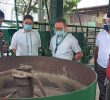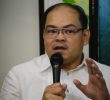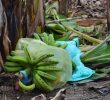Since it is the tallest mountain in the country, any of these changes, he said, could also have an impact on the country’s climate condition.
.jpg)
Leonilo Rivera, chief of the Department of Environment and Natural Resources (DENR) protected area and wildlife division, explains Hedcor’s project in Tudaya. DENR granted Hedcor an Environmental Compliance Certificate (ECC) in 2004 which paved the way for the construction of two hydroelectric power plants within the 86-hectare area spanning the barangays of Sibulan and Darong in Sta. Cruz town of Davao del Sur. (davaotoday.com photo by Jonald Mahinay)
The construction of a dam, according to experts, would cause not only destruction to the natural habitat but could also be harmful to the health of inhabitants.
Dr. Romy Quijano, professor of the Department of Pharmacology and Toxicology of the University of the Philippines, explained that the construction of a dam could upset the balance of insects, which, in turn could stimulate malaria.
Even the excavation of lands, Dr. Quijano said, �could release arsenic from the ground and could affect life downstream.�
The use of machines, stock of fuel and cleaning agents for machines is also harmful to the environment, he said.
But Leonilo Rivera, DENR’s chief of protected area and wildlife division (PAWD), explained that these are precisely the reasons they approved the Environmental Compliance Certificate (ECC) of the company.
.jpg)
The majestic Tudaya Falls. This 100-meter waterfall is the tallest in the Mt. Apo National Park. It is located in Sitio Tudaya, Barangay Sibulan, Sta. Cruz Davao del Sur. The falls which the Aboitiz-owned Hydro-Electric Development Corporation (Hedcor) intends to utilize for generating electricity to supply the region and Mindanao is a sacred ground for the Tagabawa tribe. Environmentalists also say that destroying the waterfalls and rivers of Mt. Apo will result to a loss of biodiversity which will lead to the destruction of the mountain, the tallest, and one of the few remaining rainforests in the country today. (davaotoday.com file photo by Cheryll D. Fiel)
�If you are going to develop something, you cannot really avoid some amount of environment degradation. That is why we have the ECC to mitigate that,� he told davaotoday.com in an interview.
The ECC, he said, should not be construed as a permit, but rather as a mechanism by which the government can mitigate potential adverse impacts on the environment.
Rivera explained too that Hedcor’s hydropower project is needed �to mitigate the projected power shortage of the region and Mindanao.�
Besides, the company has complied with all the requirements, he said. �Detalyada. Dumaan sila sa proseso (It is detailed. They have gone through the processes),� he said.
But questions on the manner of its consultations were already raised against Hedcor right at the start of its project.
Apo Adoc denied signing any document allowing the construction of the hydroelectric plants. He said he would never do it since �selling out lands is prohibited by our forebears,� he said.
He pointed that the �outsiders� were the ones pushing for the project.
Residents interviewed by davaotoday.com in Sitio Tudaya said that most of those who signed these documents were not of Sitio Tudaya but of neighbouring sitios (subvillages) in Sibulan.
As a show of protest, Apo Adoc, the leader of the oldest indigenous sect �Sandawa Sariling Langis,� performed a protest ritual in November 2006 right at the Tudaya falls.
But it may have been their last ritual since construction began early the following year.
Yet lumads and environmental groups are not giving up the fight.
Indigenous Peoples









